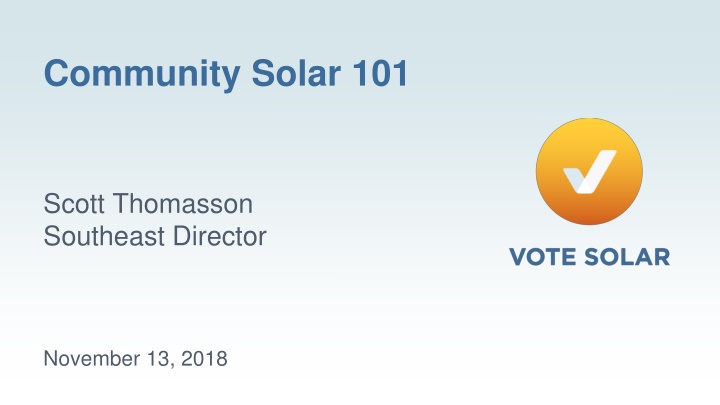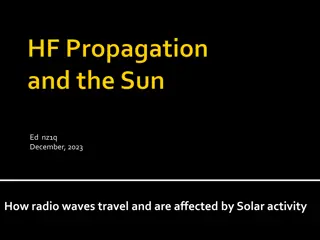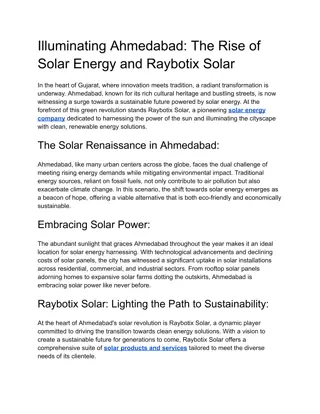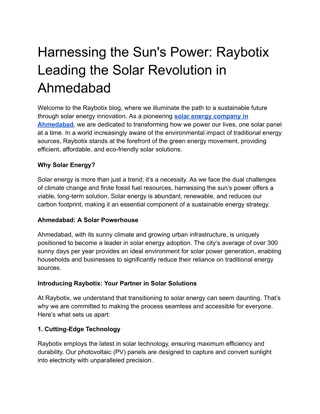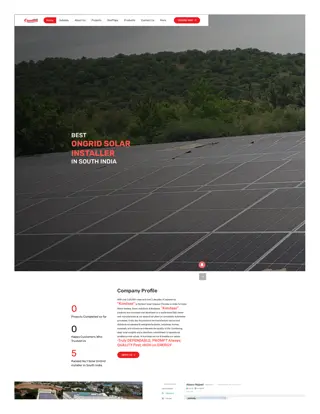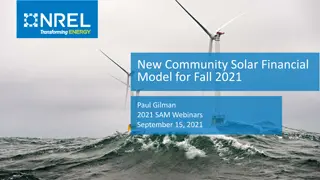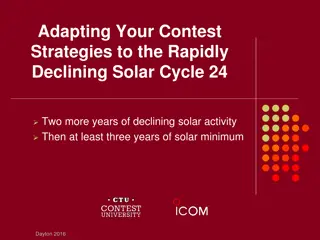The Growth of Community Solar in the US
Community solar is rapidly expanding in the United States, providing opportunities for individuals to benefit from shared solar arrays. With strong popular support, community solar projects offer a solution to limited access to on-site solar installations. Discover the benefits of community solar and how it is redefining the solar energy landscape.
Download Presentation

Please find below an Image/Link to download the presentation.
The content on the website is provided AS IS for your information and personal use only. It may not be sold, licensed, or shared on other websites without obtaining consent from the author.If you encounter any issues during the download, it is possible that the publisher has removed the file from their server.
You are allowed to download the files provided on this website for personal or commercial use, subject to the condition that they are used lawfully. All files are the property of their respective owners.
The content on the website is provided AS IS for your information and personal use only. It may not be sold, licensed, or shared on other websites without obtaining consent from the author.
E N D
Presentation Transcript
Community Solar 101 Scott Thomasson Southeast Director November 13, 2018
U.S. Solar is Rapidly Growing Cumulative Operating U.S. Solar by Market Segment (GWdc) Operating U.S. solar has grown 7x in the past 5 years 2 Source: GTM Research and SEIA U.S. Solar Market Insight Q2 2018
Community Solar Nears 1 Gigawatts of Total Operating Capacity Nationwide U.S. community solar is growing at a quicker pace than the overall U.S. solar deployments Still, community solar represents less than 2% of all operating U.S. solar to date. 67% of the capacity is administered by a third-party 3
Americans Want Solar. Overwhelmingly. 89% of Americans favor expanding solar as an energy source (2018) Pew Research Center Strong bipartisan support for increased use of solar 71% of Americans support increasing reliance on renewable energy (2018) Pew Research Center Interest in community solar soars from 14% to 47% when people learn about it (2016) SEPA Report 4
But Access to On-Site Solar is Limited 150,000 customer-sited solar energy systems by the end of 2010 2 million customer-sited solar energy systems by the end of 2018 36 million to 74 million residences and businesses without solar but suitable for onsite solar 75 million to 113 million households and businesses without onsite solar access 5 Source: GTM Research / SEIA, EIA, U.S. Census
The Solution: Community Solar What is community solar? Community solar refers to local solar arrays shared by individual community members, who receive credits on their electricity bills for their portion of the power produced. 6
Defining Community Solar The Typical Community Solar Model Over the years, many projects have been labeled community solar, but we define community solar as a solar project with multiple subscribers that receive on bill benefits directly attributable to the community solar project. SUBSCRIBERS Subscribers receive a credit on their electric bill for their share in a community solar COMMUNITY SOLAR PROVIDER UTILITY Energy and Other Grid Services Subscribers must be tied to a specific solar project 7
Why Choose Community Solar? Customer Benefits Equal Access: Gives ALL consumers equal access to solar energy, regardless of housing type or income level. A Tool for Equity. A properly designed program can help unlock the benefits of going green for LMI communities who have been priced out or have limited suitable rooftop options. Tangible Economic Savings: Customers should save money on their electric utility bill, and receive stable energy bills and predictable energy prices Hassle free clean energy: Customers can sign up to participate in a community solar project without having to worry about on-site contractors, permits, or maintenance. Flexibility: Community solar allows customers to move within the utility territory and still retain their participation in the community solar project, making it an easy, portable energy solution. 8
Consumer-focused offerings are key Average Response to Rate the Importance of the Following Attributes to You / Constituencies You Work With Subscriber economics generally come first Subscribers want tangible bill savings Tangible Economic Savings Predictability of Costs LMI customers require higher relative savings than other segments Financing Options Simplicity Alignment with Values Predictability of costs is the most important for non- residential and non-LMI residential subscribers Program Administration Autonomy Local Non-economic factors (e.g., alignment with values, the program administrator) are still important Choice Economic Impact or Co-benefits 1.0 2.0 3.0 4.0 5.0 Weighted Importance (1 = Least Important, 5 = Most Important) Source: Based on GTM Research Wood Mackenzie interviews and surveys with two dozen community solar developers, customer representatives and stakeholders 9
Levelized Cost of Energy: Lazard Review Nov 2017 Gas Peaking Residential Solar Nuclear Rooftop C&I Solar Community Solar High Low Coal Utility Scale Solar - Crystalline Natural Gas Combined Cycle Wind 10 $0 $50 $100 $150 $/MWh $200 $250 $300 $350 Source: Lazard LCOE 11.0
Where is Community Solar? 42 states and Washington, D.C. currently have some voluntary community solar projects, but only 19 states and D.C. have statewide programs that provide an early opportunity for community solar to scale. Policy-Enabled Market One-Off Programs (1-5) One-Off Programs (5+) 11
State Policy Drives Substantial Growth Policy-enabled markets account for 71% of all currently operating community solar capacity. Figure 1: Third Party Administered Capacity Figure 2: Utility Administered Capacity 12 Image Source: Smart Electric Power Alliance. Community Solar Program Design Models. Data from December 31, 2017
Why isnt Community Solar Everywhere? 31 states across the country without laws that explicitly allow for community solar Utilities can voluntarily launch community solar programs but these take time, have historically been offered at an extra cost, and result in limited capacity and available subscriptions SOLUTION: Statewide programs mandated at the state legislature drive solar projects, create jobs, can include meaningful low-income provisions and may be designed to maximize the customer value proposition. 13
Case Studies: Individual Projects
Case Study: Denver Housing Authority Project Location: Colorado Project Summary: 2 MW community solar project The project s output will benefit DHA housing as well as other Low-income Housing Tax Credit and Public Housing Buildings in the Denver metro region The project offers 15-20% savings average monthly electricity bills for these properties, which flow to residents via reduced and predictable energy rates, etc. Developer: Denver Housing Authority, in partnership with GRID Alternatives and Namaste Solar 15
Case Study: Statewide Programs
Case Study: Minnesota Enacted in 2013 Uncapped program that uses value of solar credit rate as opposed to retail rate. Systems have a 1 MW size limit. Over 430 MW deployed so far and continues to grow. 17 https://ilsr.org/minnesotas-community-solar-program/
Case Study: Colorado Pros Program started with 5% per project for low-income households. Applied lessons learned to improve the program structure. 13.5 MW of 100% low-income community solar projects (2017 2019) Include affordable housing in the definition of low-income Competitive solicitation evaluates bill savings, coordination with energy efficiency measures, and job training Funding streams and incentives available through 2% rider on all ratepayers bills Cons Limited by annual utility solicitations for capacity Restrictive siting criteria 18
Case Study: Massachusetts Part of MA s net metering program no difference between Virtual Net Metered (VNM) facilities and non-VNM facilities Prior State Incentive Program (SREC II applied factors Up to 25% higher SRECs value for affordable housing projects Result: 202 MW of solar serving affordable housing, the highest in the country per capita. New incentive program (SMART) 6 cents / kWh adder for projects serving 50% low-income 19
Case Study: New Jersey Note: Still in rulemaking Legislation passed in 2018 and signed into law by Governor Murphy NJ can expect the following economic benefits if 450 MW of distributed community solar is installed between 2019 2021 1,778 sustained full-time jobs during construction $414.7 million in earnings for those employed $797.9 million in local economic benefits for the state, excepting local tax revenues $3.3 million from property tax revenues in the first year alone 20
Community Solar is small today but It can rapidly become a mainstream energy source U.S Community Solar can grow 50 80 times its current size by 2030 21
Relevant Resources National Renewable Energy Laboratory State Considerations for Designing Community Solar Policy https://www.nrel.gov/docs/fy18osti/70663.pdf Coalition for Community Solar Access Resource and Policy Decision Matrix http://www.communitysolaraccess.org/wp-content/uploads/2016/03/CCSA-Policy-Decision-Matrix-Final- 11-15-2016.pdf Vote Solar and GRID Alternatives Low Income Solar Policy Guide, Community Solar http://www.lowincomesolar.org/practices/community-solar/ Interstate Renewable Energy Council (IREC) Guiding Principles & Shared Solar Catalog: https://irecusa.org/regulatory-reform/shared-renewables/ IREC and Vote Solar s Voluntary Utility-Led Community Solar Program Checklist https://votesolar.org/cschecklist The Vision for U.S. Community Solar: A Roadmap to 2030 https://votesolar.org/csvision Clean Energy States Alliance Bringing the Benefits of Solar Energy to Low-Income Consumers https://www.cesa.org/projects/sustainable-solar/resources/resource/bringing-the-benefits-of-solar-energy- to-low-income-consumers 22
